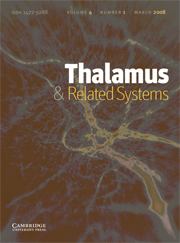Article contents
The role of the thalamus in cortical function: not just a simple relay
Published online by Cambridge University Press: 19 February 2007
Abstract
Recent work on the visual thalamic relays provides two key properties reviewed here. First, ∼95% of input to lateral geniculate relay cells is non-retinal and dynamically modulates the relay based on behavioral state, including attention. Part of this relates to control of a voltage-gated, low-threshold Ca2+ conductance that controls the relay cell response mode (tonic or burst). Second, the lateral geniculate nucleus and pulvinar are examples of two relay types: the former is a first order relay, transmitting subcortical (retinal) information, while the latter is mostly a higher order relay, transmitting information from layer 5 of one cortical area to another. Higher order relays seem to be important to corticocortical communication, which challenges the dogma that such communication is based on direct cortico–cortical connections. Other examples of first order and higher order relays also exist. Interesting differences in functional circuitry between first and higher order thalamic relays are beginning to accumulate, which indicate extramodulatory functions for higher order relays. Thus, the thalamus provides a behaviorally relevant, dynamic control over the nature of information relayed, and also plays a key role in basic cortico–cortical communication.
Keywords
Information
- Type
- Research Article
- Information
- Copyright
- 2007 Cambridge University Press
- 12
- Cited by

